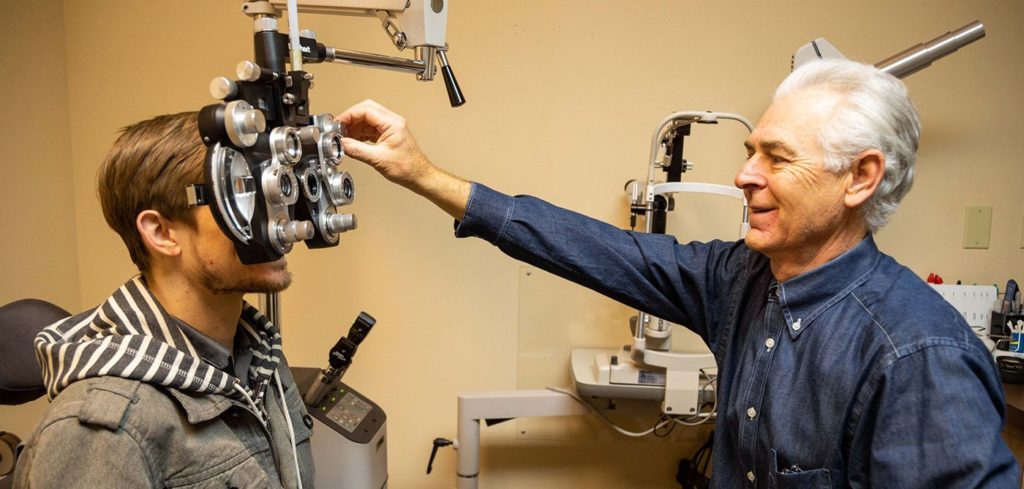Approximately 33% of the people in the U.S. have some degree of astigmatism – but is this a serious eye condition?
An irregularity in the cornea’s curve, the front of the eye, causes astigmatism. In layman’s words, an astigmatic eye’s curvature resembles that of a football rather than a baseball.
Here are the top 9 FAQs on astigmatism.
What is astigmatism?
Most times astigmatism is not a serious eye condition, but causes eye strain and fatigue – impacting school and office performances.
However, astigmatism can sometimes hide a sight-threatening eye condition.
Astigmatism, like myopia (nearsightedness) and hyperopia (farsightedness), is a common refractive error. When light enters the eye, it is not evenly dispersed across the retina, resulting in blurry vision.
Most people will develop astigmatism at some point in their lives, and it can impact both children and adults and have a negative effect on a child’s schooling and learning.
Astigmatism can occur on its own or in tandem with nearsightedness or farsightedness. Astigmatism can produce blurry vision in both close and far distances, as well as headaches, eye strain, and fatigue.
Fortunately, astigmatism is an easy problem to treat, and there are several options.
How does astigmatism affect vision?
Astigmatism is a common vision problem caused by an error in the shape of the cornea. With astigmatism, the lens of the eye or the cornea, which is the front surface of the eye, has an irregular curve.
This irregular curve of the cornea causes light rays that are vertical to be focused differently to those that are horizontal – often making straight lines appear slanted or an overall feeling that your vision is not as sharp as it should be.
This can change the way light passes, or refracts, to your retina, causing blurry, fuzzy, or distorted vision.
Signs of astigmatism
Astigmatism symptoms vary from person to person. Some people show no signs or symptoms at all.
Astigmatism may show itself in the following ways:
- Difficulty seeing at night
- Eye irritation
- Eyestrain
- Headaches
- Squinting
- Distorted, blurry or fuzzy vision at all distances (up close and far away)
What are the best treatments for astigmatism?
Astigmatism can be treated using orthokeratology (ortho-k) or laser eye surgery, or it can be corrected with eyeglasses or contact lenses.
Eyeglasses for astigmatism
The most common way to correct astigmatism is with eyeglasses, and it’s usually the first thing a patient attempts if they have the condition. The glasses have a one-of-a-kind cylindrical lens prescription that rectifies astigmatism. The American Optometric Association found that people with astigmatism often choose glasses to improve their vision.
According to the American Academy of Ophthalmology, correcting astigmatism using eyeglasses can typically result in 20/20 vision. Additional treatments may be required if the degree of astigmatism in the eye is considerable.
Schedule an eye exam with an eye doctor near you, to discuss how to treat your astigmatism.
SEE RELATED: Nearsighted or Farsighted?
Contact Lenses for astigmatism
1, Toric contact lenses
Astigmatism is frequently corrected with toric lenses, which are a special form of soft contact lens. A toric lens is a contact lens that has a specific shape.
The surface of standard contact lenses is spherical, like a slice of the side of a beach ball. A torus, on the other hand, is a donut-shaped geometric shape. A toric lens looks like a slice of this donut’s side.
Toric contact lenses have different refractive, or focusing, capabilities in vertical and horizontal orientations due to its form. As you go around the lens, the refractive strength progressively increases or decreases.
Toric contact lenses treat astigmatism caused by a variable curvature of the cornea or lens in your eye. Toric contact lenses’ ability to give varied refractive powers in vertical and horizontal orientations addresses this unique feature that causes astigmatism.
- Orthokeratology (Ortho-k)
Orthokeratology is a type of treatment that entails wearing customized contact lenses. Ortho-k are worn when you sleep, until your eye’s curvature is temporarily corrected. During the day, vision remains clear without the use of glasses.
Your eyes may revert to their previous shape and refractive error if you stop using the lenses at night.
Can laser eye surgery treat astigmatism?
Yes.
Patients with low astigmatism are usually candidates for laser eye surgery.
A laser is used to remove a little amount of corneal tissue to reshape the curvature of the front of the eye.
After that, the eye should have the shape of a soccer ball rather than a football. This modification allows light to focus on a single point on the retina, resulting in clear vision.
What are the best glasses for astigmatism?
1. Frame size and shape
Astigmatism is improved by frames that are flatter. Wraparound or curved frames might distort your eyesight by bending the light.
To keep your vision clear and in focus, choose a frame that sits securely on the bridge of your nose.
2. Lens material
Astigmatism that is more severe sometimes need a thinner lens than regular lenses. For high prescriptions, high index or Trivex lenses are frequently used.
Standard plastic lenses are less expensive and can be useful for astigmatism with low levels.
3. Specialized lens coatings
You have the option of applying custom coatings to your glasses every time you order them. Anti-scratch, UV-blocking, and blue-light blocking are some of the options offered.
To increase the quantity of light that enters the eye, those with astigmatism may choose to use anti-glare or anti-reflective coatings. It’s also crucial to keep your lenses clean in order to get the most amount of light for a clearer image.
LEARN MORE: Guide to Eye Health
Schedule an eye exam with an eye doctor near you to find out if you have astigmatism and to what extent.
Most times astigmatism is not a serious eye condition, but can cause distorted vision, eye strain, headaches and fatigue.
Astigmatism can impact your school and office performances.

